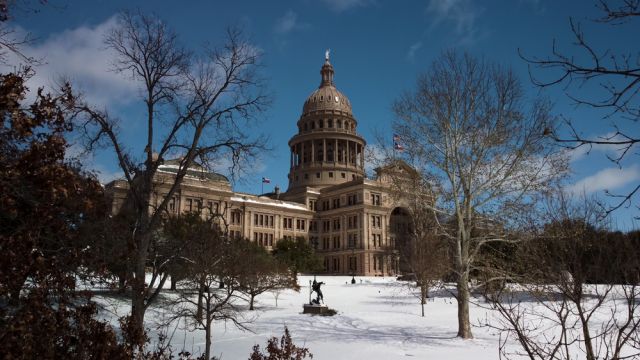
Even with U.S. gas demand significantly rising from recent freezing temperatures, analysts do not expect a repeat of the storm that shut down Texas in 2021 and covered the state in snow. (Source: Shutterstock)
U.S. gas production took a major hit from the arctic vortex that froze most of the U.S. and other parts of the globe beginning Jan. 13.
Still, most production companies and local utilities were not suffering major outages as of Jan. 16, and analysts did not expect a repeat of the storm that shut down Texas in 2021. And the U.S. has plenty in the tank: domestic natural gas storage was at a five-year high last week, according to the U.S. Energy Information Administration.
The result is most likely a massive spike in demand.
“The overall level of demand seen from the storm system was significant,” said Jack Weixel of East Daley Analytics. There are several key differences between the arctic blast hitting on Jan. 16 and Winter Storm Uri in 2021, which famously knocked out power in Texas for the better part of a week.
“One, (the most recent storm) was not cold enough to shutter power plants or residential gas utility deliveries and create demand destruction,” Weixel said. “Two, it was just cold enough to make residential, commercial and power demand high enough to stress systems to a large degree.”
Weixel also said natural gas producers also have much larger LNG export obligations to worry about than two years ago. The result would be a daily demand 30% to 35% higher than usual for January, he said.
Other analysts noted evidence was already available that the demand would be as heavy as expected.
Financial firm LSEG, which tracks market commodities, reported its data indicated U.S. natural gas demand would jump by more than 20 Bcf/d from the Martin Luther King Jr. Holiday on Jan. 15 to 170 Bcf/d on Jan. 16, Reuters reported.
The number would top the all-time high of 162.5 Bcf/d recorded during Winter Storm Elliot in December 2022. Every 1 Bcf of gas is enough to fuel about 5 million U.S. homes for a day.
LSEG also noted that gas production fell to 92.8 Bcf/d on Jan. 15, its lowest level in 13 months, also recorded at the same time as Elliott. Gas production is especially vulnerable to cold snaps as frigid temperatures can freeze wells and interfere with pipeline production.
One of the biggest outages due to the cold snap was in North Dakota. The state’s natural gas output was estimated to drop by almost half, from 3.44 Bcf/d to 1.8 Bcf/d because of the weather, according to Reuters.
Kinder Morgan, which reported “strained operating conditions” on its El Paso Natural Gas Pipeline on Jan. 15, had cleared the warning a day later.
In Texas, the Electric Reliability Council of Texas (ERCOT), urged customers to cut back on usage on Jan.16, but also reported that disruptions to service had been minimal.
“Localized issues, including compression outages, suspension of water hauling and instrument performance were experienced overnight, but personnel are in place to resolve these issues during the day. Even with these issues, there has been minimal impact to the overall natural gas production and distribution system,” ERCOT said in a release.
Once weather conditions return to normal, Weixel said he did not expect the storm to have a lasting impact.
“Sure, cash prices spiked across the country, but the February prompt month price has actually dropped about 12% since Friday [Jan. 12]” by about $0.40, he said. “The reason for this is a quick warm-up in the forecast for the balance of the month and only a marginal change to the overall working gas inventory estimate for end of March.”
Recommended Reading
Marketed: Paloma Natural Gas Eagle Ford Shale Opportunity in Frio County, Texas
2024-02-16 - Paloma Natural Gas has retained EnergyNet for the sale of a Eagle Ford/ Buda opportunity in Frio County, Texas.
Marketed: Williston, Powder River Basins 247 Well Package
2024-03-11 - A private seller has retained EnergyNet for the sale of a Williston and Powder River basins 247 well package in Sheridan, Montana, Burke and McKenzie counties, North Dakota and Campbell County, Wyoming.
Marketed: Onyx Resources 23 Well Package in Texas
2024-03-25 - Onyx Resources has retained EnergyNet for the sale of a 23 well package plus 1,082.81 net leasehold acres in Archer, Clay, Fisher, Jones, Kent, Stephens, Taylor and Young counties, Texas.
Marketed: Bendel Ventures 73 Well Package in Texas
2024-03-05 - Bendel Ventures LP has retained EnergyNet for the sale of a 73 well package in Iron and Reagan counties, Texas.
Marketed: EnCore Permian Holdings 17 Asset Packages
2024-03-05 - EnCore Permian Holdings LP has retained EnergyNet for the sale of 17 asset packages available on EnergyNet's platform.
